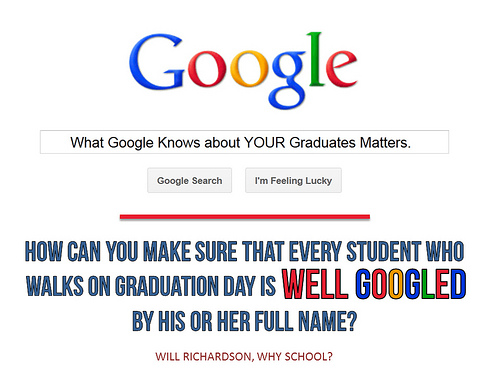My students often travel with me when I lead professional development at conferences. A few weeks ago, eight-year-old Carson Griffin (pictured here to the right) was helping me lead a session for teachers on “iPads for Elementary Learners,” and we were talking about our classroom Twitter account as it applies to digital citizenship. I called Carson to the front of the room to share his thoughts on Digital Citizenship, and his response gave me goosebumps.
“You should never post anything negative about a teacher, coach, or others on social media because they could find it and you will feel foolish,” he said. “If my coach doesn’t play me in soccer, I should not post bad stuff about them. I could be kicked off the team.”
But he didn’t stop there. “Even if you think it is deleted, it can always be found… Ask yourself: is it true, helpful, inspiring, necessary, and kind? If it’s not, you shouldn’t be posting it online. When you grow up, you use technology and your digital footprint to get you into jobs.”
I’m not sure if it was the teachers’ reactions, the fact that he so beautifully recited this during the summer, or that I know I helped him secure his future in second grade that made this such a powerful moment for everyone in the room. I teared up on the spot.
Our students are constantly connected with each other and the world through their devices. In fact, the students in my second grade classroom have never lived without WiFi or mobile devices. They have never felt the pain of dial-up internet or T9 texting. But… how can we ensure that what our students are doing on these devices is appropriate and meaningful?
Why Digital Citizenship is No Longer Just an “Elective”
As teachers, it is now part of our responsibility to lead by example when it comes to sound digital citizenship practices. As soon as children have devices in their hands, they should be educated about digital citizenship and their digital footprint. Think about this: even before babies are born, they have a digital shadow, because pictures and other media are shared about them via various social media outlets.
There is a startling statistic that 93 percent of employers now use social media in some way to either recruit or hire employees. That means that if I don’t educate students about digital citizenship, they may end up having a poor or neutral digital footprint--which means they have a 7 percent chance of getting hired. While media specialists teach these skills, it is essential that classroom teachers are embedding it into their classroom curriculums as well as soon as students are online. We also can’t assume that families are educating students about their digital footprint. In fact, this year, a mother told me that her son was teaching her about what was appropriate to post online--and she thanked me at our parent teacher conferences!
George Couros challenges teachers to make sure all students are well “Googleable” when they graduate, and I think this is a vital concept to embrace and take on. My students call me a “Digital Role Model,” and I have to admit I like that title. They enjoy Googling me to check on my digital footprint, and see all of the places I’ve traveled to for conferences, or golf meets I competed in during college. They have full access to view my Instagram, Pinterest, Twitter, and blog. Knowing this reinforces my belief that I need to be a strong digital role model for them and lead by example. If I’m going to talk the talk, I better walk the walk.
Here’s how you and your students can walk the walk in your own classroom, too. Let’s start with resources.

Resource Roundup
When it comes to resources to support teaching Digital Citizenship, there are several out there. A few favorites I use throughout the year include:
- Planet Nutshell Videos: These are short videos that cover a variety of topics from cyberbullying to protecting personal information.
- Common Sense Media: This amazing site has tons of FREE materials that are designed to empower students to think critically, behave safely, and participate responsibly in our digital world.
- PBS Kids Webonauts Academy: The Webonauts Internet Academy empowers kids to make responsible and respectful decisions in their online interactions.Taking on the role of a Webonaut, kids explore a series of missions that teach key issues of web safety and digital citizenship.
But, keep in mind--I’m a huge fan of DIY when it comes to Digital Citizenship resources.
I created the main resource collection I use in my classroom to introduce Digital Citizenship and to fill the needs of my students. (You can buy it here!) Some of the topics included in my resource center around keeping private information private, making safe and appropriate choices online, being respectful of others, reporting bullying, and citing sources.
Looking to make your own collection? Here’s what I include:
- Seven posters for classrooms with scripted mini-lessons and turn-and-talk discussion suggestions
- A letter for parents (because the parent education piece is essential)
- Student response readers
- Differentiation options for intermediate learners
- A “certificate of completion” for the students
After working through my resource, the work really begins. Students need to be given real world opportunities to begin building their digital footprint. My resource simply helps stir up the discussion and lay the foundation with your students.
Give Students Access--and Start Small
I’m a believer in guiding students through real world, authentic situations to teach them digital citizenship skills. If schools block students from everything, they may be “protecting” them temporarily during the school day. However, when schools teach students about their digital footprint and give them tools to use in real life situations, they protect students for a lifetime. So, for starters, allow students access to YouTube, search engines, and Twitter at school. Prepare them beforehand with extensive discussion and tools, and set them up for success.
One of my favorite ways I teach and instill Digital Citizenship in my classroom is through “Tweeter of the Day.” I think it is vital to provide students with an authentic platform to show what they know and put their digital citizenship skills to the test. While having students update “tweets” on sentence strips on a bulletin board might have a purpose, it’s not the same as providing them with the real thing.
Each day, a different Tweeter is assigned, and this role includes live tweeting our learning throughout the day, where the student starts with an introduction, and often will tweet learning, pictures, and sometimes videos. The Tweeter is also responsible for responding to tweets our account receives throughout the day, such as those that we received from global connections like Brad Waid and Jen Jones. All tweets are monitored by me as a teacher, but I am more of a facilitator and the account truly belongs to the students.
My challenge to teachers is always, “If it’s right for kids, it’s right.” While jumping into technology or social media can be scary at first, the benefits of putting kids in authentic environments to hone their digital citizenship skills far outweigh those fears. Sometimes, the comfort level of teachers is less important than doing what’s right for students as we prepare them for the future that waits for them when they leave school. We as teachers cannot play into those fears, or be the four walls that hold our students back.


